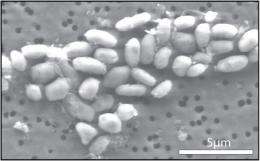December 9, 2010 report
Critics raise doubts on NASA's arsenic bacteria

(PhysOrg.com) -- NASA’s announcement last week that bacteria had been discovered that appeared to replace phosphorus with arsenic and thrive even in the most poisonous environments, has now come under fire from a number of scientists.
The findings reported last week, were that some bacteria (GFAJ-1) thrived when access to phosphate was removed and the bacteria were grown in a highly toxic culture rich is arsenate. The scientists suggested the bacteria thrived because they were able to replace phosphorus, which has always been thought vital to life, with arsenic, which is directly under it on the periodic table and has similar chemical properties. The researchers also suggested the bacteria were replacing phosphorus with arsenic within the bases that make up DNA.
These findings, if correct, would mean the scientists had found a new form of life on Earth, and it would also re-write the guide book on the essential requirements for life to exist elsewhere.
After the findings were published in Science, other scientists began immediately to express their doubts at the conclusions of the paper, with some even expressing the opinion the paper should not have been published at all.
One of the critics was Dr. Alex Bradley, from Harvard University, who blogged that there were a number of problems with the research. Firstly, if arsenic had replaced phosphorus in the DNA the molecule would have broken into fragments when the DNA was placed in water, since the arsenic would have hydrolyzed, and yet it did not. Secondly, the paper showed there was a small amount of phosphorus in the medium and Bradley argued that even though small, this could have been enough, since bacteria metabolism is extremely efficient.
Dr. Bradley also pointed out the bacteria live in Mono Lake, which is rich in arsenic but which also contains a higher concentration of phosphate than almost anywhere else on Earth, and this means there would be no selective pressure for a life based on arsenic to evolve.
Dr. Bradley also suggested a mass spectrum of the DNA sequences would have shown whether or not the nucleotides contained arsenic in place of phosphorus, but this was not done.
Another critic was University of British Columbia biologist Rosie Redfield, who reviewed the paper on her blog, and has more recently submitted a letter to the journal. Among her conclusions are that the paper “doesn't present ANY convincing evidence that arsenic has been incorporated into DNA (or any other biological molecule).” She also writes: “If this data was presented by a PhD student at their committee meeting, I'd send them back to the bench to do more cleanup and controls.”
Dr. Redfield also points out there was phosphate in the culture and that the authors did not calculate whether the amount of growth they saw in the arsenate-only medium could be supported by the phosphate present. She calculates on the blog that the growth of the bacteria is actually limited by the amount of phosphorus.
Another point made by Redfield is that the arsenic bacteria were “like plump little corn kernels” and contain granules, which are usually produced by bacteria when they have ample supplies of carbon and energy sources but there are shortages of other nutrients needed for growth.
The authors of the arsenic bacteria paper initially refused to be drawn into the arguments, saying the discussion should be confined to peer-reviewed journals, but one of the authors, Ronald Ormeland, did answer questions on the controversy after giving a lecture on the findings at NASA headquarters yesterday. He said the amount of phosphorus in the sample was too small to sustain growth, and a mass spectrum was not done because they did not have enough money, and wanted to get the result published quickly. He also pointed out that the bacteria are still there and other scientists could duplicate the work and carry out further experiments if they wished.
© 2010 PhysOrg.com




















